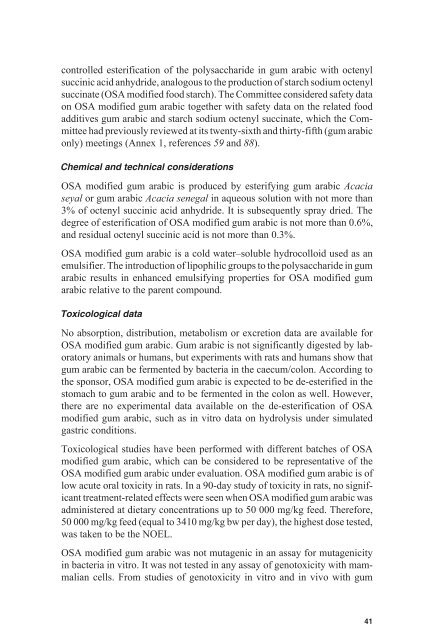evaluation of certain food additives - libdoc.who.int - World Health ...
evaluation of certain food additives - libdoc.who.int - World Health ...
evaluation of certain food additives - libdoc.who.int - World Health ...
Create successful ePaper yourself
Turn your PDF publications into a flip-book with our unique Google optimized e-Paper software.
controlled esterification <strong>of</strong> the polysaccharide in gum arabic with octenyl<br />
succinic acid anhydride, analogous to the production <strong>of</strong> starch sodium octenyl<br />
succinate (OSA modified <strong>food</strong> starch). The Committee considered safety data<br />
on OSA modified gum arabic together with safety data on the related <strong>food</strong><br />
<strong>additives</strong> gum arabic and starch sodium octenyl succinate, which the Committee<br />
had previously reviewed at its twenty-sixth and thirty-fifth (gum arabic<br />
only) meetings (Annex 1, references 59 and 88).<br />
Chemical and technical considerations<br />
OSA modified gum arabic is produced by esterifying gum arabic Acacia<br />
seyal or gum arabic Acacia senegal in aqueous solution with not more than<br />
3% <strong>of</strong> octenyl succinic acid anhydride. It is subsequently spray dried. The<br />
degree <strong>of</strong> esterification <strong>of</strong> OSA modified gum arabic is not more than 0.6%,<br />
and residual octenyl succinic acid is not more than 0.3%.<br />
OSA modified gum arabic is a cold water–soluble hydrocolloid used as an<br />
emulsifier. The <strong>int</strong>roduction <strong>of</strong> lipophilic groups to the polysaccharide in gum<br />
arabic results in enhanced emulsifying properties for OSA modified gum<br />
arabic relative to the parent compound.<br />
Toxicological data<br />
No absorption, distribution, metabolism or excretion data are available for<br />
OSA modified gum arabic. Gum arabic is not significantly digested by laboratory<br />
animals or humans, but experiments with rats and humans show that<br />
gum arabic can be fermented by bacteria in the caecum/colon. According to<br />
the sponsor, OSA modified gum arabic is expected to be de-esterified in the<br />
stomach to gum arabic and to be fermented in the colon as well. However,<br />
there are no experimental data available on the de-esterification <strong>of</strong> OSA<br />
modified gum arabic, such as in vitro data on hydrolysis under simulated<br />
gastric conditions.<br />
Toxicological studies have been performed with different batches <strong>of</strong> OSA<br />
modified gum arabic, which can be considered to be representative <strong>of</strong> the<br />
OSA modified gum arabic under <strong>evaluation</strong>. OSA modified gum arabic is <strong>of</strong><br />
low acute oral toxicity in rats. In a 90-day study <strong>of</strong> toxicity in rats, no significant<br />
treatment-related effects were seen when OSA modified gum arabic was<br />
administered at dietary concentrations up to 50 000 mg/kg feed. Therefore,<br />
50 000 mg/kg feed (equal to 3410 mg/kg bw per day), the highest dose tested,<br />
was taken to be the NOEL.<br />
OSA modified gum arabic was not mutagenic in an assay for mutagenicity<br />
in bacteria in vitro. It was not tested in any assay <strong>of</strong> genotoxicity with mammalian<br />
cells. From studies <strong>of</strong> genotoxicity in vitro and in vivo with gum<br />
41

















